Recording be be brutal. Tracking vocals is tough. Capturing pianos or acoustic guitars is painstaking work. But recording electric guitars is easy, easy, easy—once you learn a few basics.
The post focuses on the simplest way to record a guitar amp: sticking a single mic in front of a speaker. In future posts we’ll tackle the tricky stuff: multiple mics, unorthodox mic positions, amps in shower stalls or aluminum trash cans. Those techniques are great—but you don’t need any arcane tricks to record great electric sounds. You don’t even have to have a fancy mic—countless great guitar tracks have been recorded with the humble Shure SM-57.
In fact, if the guitar, amp, and performance sound good, it’s actually pretty difficult to screw things up. Basically, you’ve got two things to consider: Which mic to use, and where to stick it. We’ll tackle those topics in reverse order.
Let’s talk placement: You get the brightest, crispiest sound when you aim the mic directly at the center of the speaker. As you move it further to the toward the edge of the speaker cone, the tone grows progressively softer and more diffuse. The distance from the speaker makes a difference too. If the mic is very close—right on the grille cloth, or an inch or two away—you get a touch of extra bass thump, just like you encounter when you move in real close on a vocal mic. (The technical term is “proximity effect”.)
Here’s the idea in diagram form:
Here’s another view of those six positions, as seen looking down at a 1×12″ combo amp. (The mic shown in an AKG 414, a fairly high-end condenser-type model.)
Now let’s hear the six positions:
AKG 414, Position 1
AKG 414, Position 2
AKG 414, Position 3
AKG 414, Position 4
AKG 414, Position 5
AKG 414, Position 6
As you can hear, sliding the mic around an inch or two can have a significant effect on the tone. It’s an organic approach to EQ. Want to brighten the tone? Move the mic toward the center of the speaker. Too much boominess? Back it off until it’s about eight inches from the grille cloth. If you can correct tones via mic placement, the results will almost always be more musical and natural-sounding than using after-the-fact EQ.
Even more important is your choice of mic. (True story: I once interviewed the great producer Daniel Lanois in his studio. We were talking about analog sound versus digital, and at one point he just shrugged. “You know what?” he said, pointing to two nearby microphones. “The difference between this mic and that one is 100 times more meaningful than analog vs. digital.”)
When it comes to miking guitar cabinets, condenser mics, like the 414 demoed above, tend to have a balanced, even response, but can sometimes lack punch and personality. Dynamic mics, like the aforementioned Shure SM-57, sound bright and crisp, but can sometimes seem thin and brittle. Ribbon mics, such as the popular Royer R-121, sound deep and warm, but can sometimes lack high-end impact.
Let’s hear the inexpensive Shure SM-57 in the same six positions. We’ll encounter the same relative differences we heard with the AKG 414, but all the Shure examples will sound brighter and crisper because that’s the nature of the mic.
SM-57, Position 1
SM-57, Position 2
SM-57, Position 3
SM-57, Position 4
SM-57, Position 5
SM-57, Position 6
Finally, let’s check out the Royer R-121, a ribbon-type mic that has become incredibly popular for electric guitar recording over the last decade or so. It’s the warmest tone of the trio, with lots of full, fat lows.
Royer R-121, Position 1
Royer R-121, Position 2
Royer R-121, Position 3
Royer R-121, Position 4
Royer R-121, Position 5
Royer R-121, Position 6
A few more tips:
• Some mics, such as the AKG 414 heard here, have switchable pickup patterns, while others, such as the 57 and the Royer, are fixed. Basically, the pickup patterns determine the degree to which the mics “listen” only to what’s directly in front of them, and to what extent they pick up sounds coming from other directions. The 57 listens only to what’s directly in front of it, which contributes to its sharp, edgy tone. The Royer listens through both its front and back sides, so it picks up more of the sound reflecting off the floor and walls. This softens the tone and adds a touch of ambience—you hear more of the room. And the 414 is switchable between four settings. (I used the “figure 8” setting for the demo, similar to the pickup pattern of the Royer.)
• In a multi-speaker cabinet, one speaker may sound better than the others, so record a bit of each and compare.
• The speaker might not be exactly where you think it is. If you can’t discern the center and edge of the speaker through the grille cloth, shine a flashlight through the grille. You can mark the dimensions with bits of painter’s tape.
• Sometimes it’s cool to mic more than one speaker, but you don’t need to do so to capture the color of multiple speakers. A single mic on a single speaker will “hear” a bit of the other speakers, which colors the sound. In other words, even when using only one mic, a 1×12″ cabinet sounds different than a 4×12″.
Remember, mic choice and placement can be corrective. For the demo lick I used the bridge pickup on the humbucker-equipped Strat I wrote about here. It’s a shimmery-bright clean tone, once that, to my ear, sounds too thin and bright through the SM-57. On the other hand, if it was fat, compressed, distorted sound, the brittleness of the 57 might be just the right touch. If in doubt, choose and position mics in ways that balance the tendencies of the guitar tone you’re recording.
So—do any of you mic mavens out there have any cool tips and tricks? Cough ’em up!
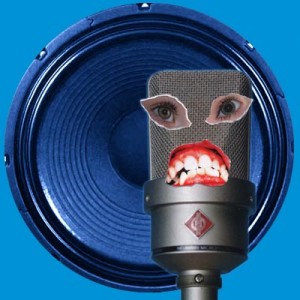
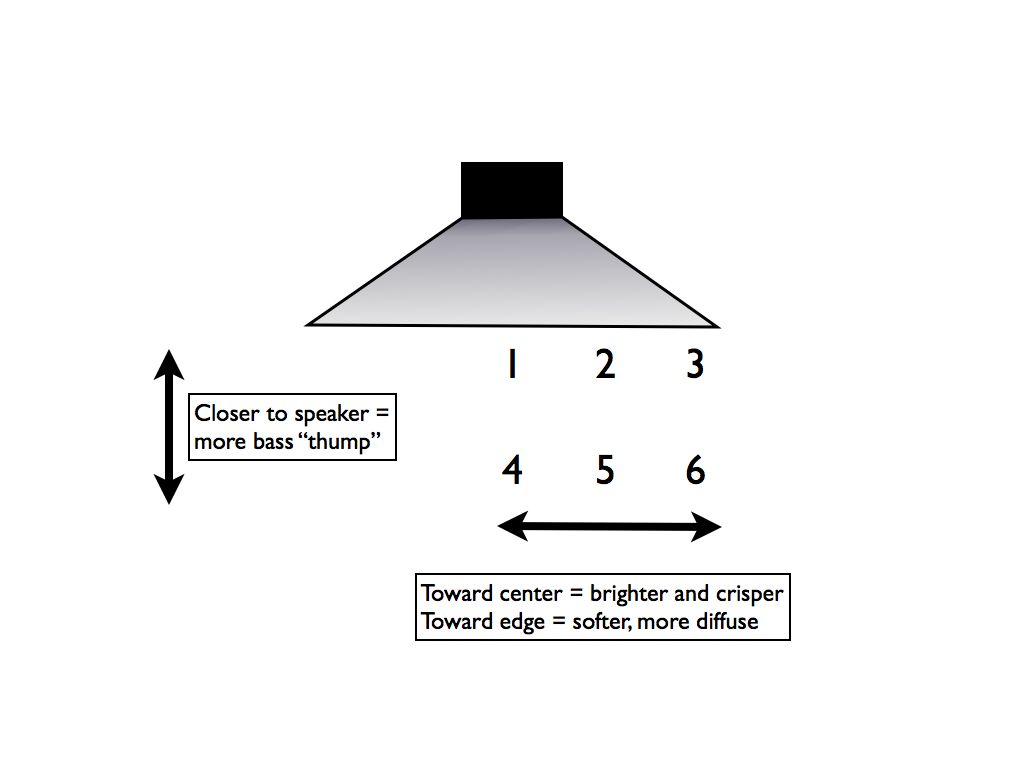
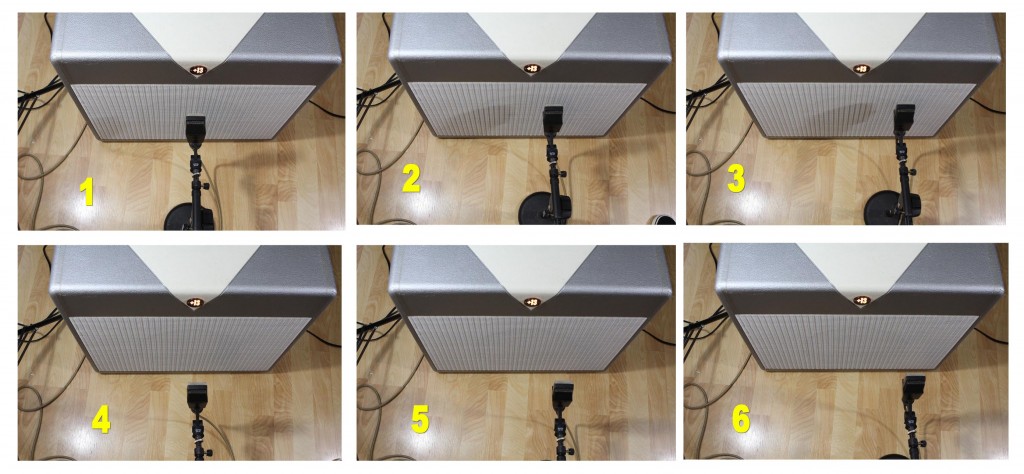
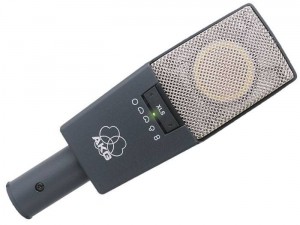
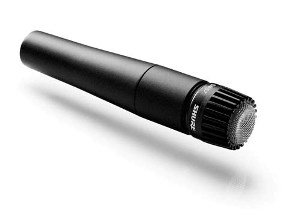
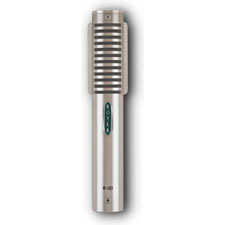








Hello,
Interesting post. I’m usually placing the microphone off-axis 90 degrees and like 1m far away to get a dark and in-the-room kind of sound.
Here are some photos of how Steve Albini places the microphones:
https://www.facebook.com/album.php?aid=194802&id=11062527887
Thanks for posting that! Note all those reflective brick walls . . .
At one time, before I was awakened to the realities of tube vs. solid state amps and digital vs. analog effects, I tried to get a decent recording out of crap gear. I had fairly good success using my crate 2×12 with a kick drum mic on one speaker and a snare mic on another in positions 3 and 1 respectively. I then mixed the two in production.
Hehehe — meanwhile, I’m preparing a post about how frickin’ awesome solid-state amps are. 😉
Yeah, I could imagine that mic combo working out great. And what’s a 57, really, but a snare drum mic? 😉
Since going tube I’ve noticed how much more they perform in live situations. Solid state sounds great alone but I always got lost when other instruments got involved.
Great article! I like the corrective aproach to using mic placement and agree 100% that it beats corrective eq, also the fact that there isn’t one “right way” to place a mic. There are just so manay variables that it will depend on each situation and what you are looking for in your guitar.
Now going to the eternal debate of tube vs solidstate vs digital/modeling vs hybrids…. I guess it all depends on the situation and the sum of all the variables and most importantly, finding the “sweet spot”. For example for Derick, his solidstate crate and guitar, effects, etc combination probably didnt work for him or for what he was looking for, but it doesnt necesarily mean that SolidState amps sound bad. The same could be the other way around, that with a different guitar, effects, cables, strings etc, his same tube amp probably wont sound so good, and the whole situation gets even more complicated with modeling/hybrid amps where you have a ton of parameters to play with.
In my opinion, thats where all the fun is, “Can I make this work?” tweaking a piece of gear until you stumble into that “magical” tone, the ever changing “sweat spot”.
Hey, JJ — thanks for the thoughtful comment. 🙂
Agreed.
This was very useful. I always have trouble positioning the mic while recording.
If you’re a home recorder, now is the time to get a reamp device of some kind – I use the Radial Pro RMP, but any one will do. Take a guitar track that you’ve also recorded a DI version. Now play it back through the reamper into your guitar amp and you have a free hand to move the mic around and hear what position sounds best for the track. Great if you only have yourself around in the studio.
For me, I like the sound of the e906 flat, draped over the grill halfway between the cone and speaker edge, but YMMV. Seeing Steve Albini use a Pro 37 (my secret cheap $100 used condenser) on amps gives me something to try… Don’t have the brick walls behind, but willing to see how it works.
one of my favorite techniques for unique tones is to aim the speaker into a container like a bucket or open clothes dryer, and then aim the mic into the container.
I also like to pair a front mic with a mic in the back of the amp, but I really dig out of phase tones (half my guitars are wired for out of phase).